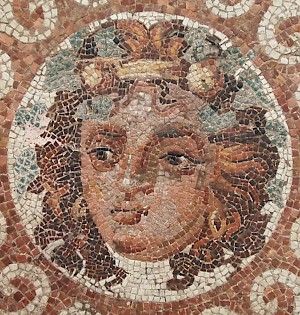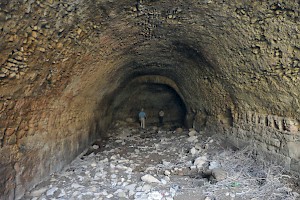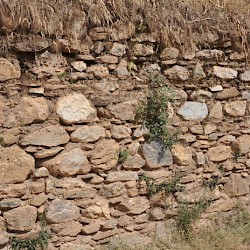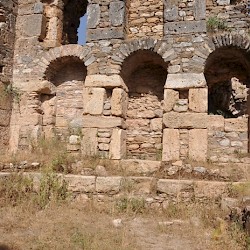Nysa
Q1779332Nysa (Greek Νῦσα): mythological place of birth of the god Dionysus.

Many lines of Homer's Iliad have inspired later authors. One of these refers to a hero named Lycurgus, who
once drove the nursing mothers of wine-crazed Dionysus over the sacred mountains of Nysa (Νυσήιον).note
When Homer wrote those lines, the Greeks had been worshipping Dionysus already for more than five centuries (the god is mentioned on Mycenaean tablets from Chania and Pylos), so there was no need to explain where Nysa was. It may have been the plain near the city of Nysa in Caria, in Asia Minor. This was close to the place where Homer lived. However that may be, later generations did not understand the line, doubted whether Nysa was a town, a plain, or a mountain, and proposed several theories, each more outlandish than the preceding one.

Some of the ancient theories placed Nysa in Boeotia, where Dionysus' mother Semele lived. The mountain Helicon and the village of Eleutherae were considered to be likely candidates.note Thrace may also have been considered quite early, if only because the god was venerated in that country. A third option was the Caucasus, on the eastern edge of the known world, because Dionysus was believed to have arrived in Greece from the east.
In the fifth century, the Greek researcher Herodotus of Halicarnassus knew a mountain named Nysa in Aethiopia,note and he may have had the Djebel Barkal in mind, where the ancient Nubians sacrificed to Amun. Antimachus of Colophon, a younger contemporary of Herodotus, appears to have picked up this clue when he moved Nysa to Arabia. He was perhaps thinking of the Arab deity whom the Greeks called Orotalt. Antimachus is quoted by Diodorus of Sicily, but also records a tradition that places Nysa in Libyan.note The cult of Shadrapa in the Phoenician colonies along the Libyan coast may be behind this move. Diodorus also records old traditions that placed the birth of the god in Elis, in Eleutherae, on Naxos, or on Teos.note

It is interesting to see that Herodotus connects the black inhabitants of Africa to the dark Indians, which must have made it easy to move Nysa to the valley of the river Swat, in the mysterious Indus country that was discovered by Alexander the Great. Here, he visited a city called Nysa near a mountain called Meros, 'thigh', which reminded the Macedonians of the myth that Dionysus was born from Zeus' thigh. The presence of ivy was sufficient evidence to prove the connection. Behind this story undoubtedly is the ancient Indian legend about the world mountain Meru. The story by Arrian of Nicomedia is told here; a description of this Indian sanctuary has survived in the Life of Apollonius by Philostratus, a late source that nevertheless contains authentic information about the Punjab (more...).
A less exotic proposal comes from the Roman author Pliny the Elder, who believed that Nysa was the ancient name of Scythopolis, one of the towns of the Decapolis (modern Beth Shean). Pliny appears to have visited the area during the Roman war against the Jews of 66-70, and must have known that the city had Dionysiac symbols on its coinage. However, it is hard to understand what led the inhabitants of the city to make this claim, even though it was not uncommon for Greek or Roman authors to identify the God of the Jews with Dionysus.note

In the sixth century, Stephanus of Byzantium, the author of a work on geography, knew ten cities called Nysa: in Arabia, in Caria, in the Caucasus, in Egypt, on Euboea, on the Helicon, in India, in Libya, on Naxos, and in Thrace. Several centuries later, the Byzantine scholar Eustathius of Thessaloniki, who had access to ancient commentaries on Homer and summarized them, decided that five candidates were acceptable (Arabia, Boeotia, Caucasus, India, and Libya).
Nysa is also mentioned as the place of the contest between Apollo and Marsyas.note The Second Homeric Hymn, to Demeter, refers to a plain of Nysa (Νύσιον πεδίον), where Persephone had been captured by Hades.note
Photos from Carian Nysa
Except for the first photo, all photos on this page are from Carian Nysa.
 Nysa, Bouleuterion, "Little Refugee" |
 Nysa, Agora, Shops |
 Nysa, Agora, Square |
 Nysa, Bouleuterion |
 Nysa, Retaining wall |
 Nysa, Street |
 Nysa, Roman bridge |
 Nysa, Library |
Photos from the theater of Carian Nysa
Some photos of the theater of Carian Nysa, with its Dionysiac decoration.



























